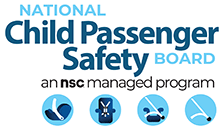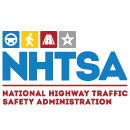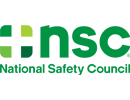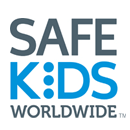Child # Assign each child a number and document.
1. Vehicle present
Identify if the caregiver arrived in a passenger vehicle that is available to perform inspection. If the caregiver arrived by public transportation, on foot, etc., select No.
2. Child Location in Vehicle
Document where the CHILD is located in the vehicle on arrival, even if the child is unrestrained. This location may be different than the location of the child’s CAR SEAT as documented in question 8.
- If no vehicle is present, select N/A.
- If the child is not physically present, select No Child Present.
3. Child’s Age
Select the age range of the child even if the child is not present.
Unborn: Select and go to #8.
0<1: Select if child’s age is less than one year. Complete #1a.
3a. If child is under 1 year, select the age in months.
Complete this question only if the child is born and less than 1 year old. Select the child’s age range in months.
4. Weight (lbs.)
Document the child’s weight in pounds. If weight is unknown, document estimated weight. Make note in the documentation box on page 2.
5. Height (in.)
Document the child’s height in inches. If height is unknown, document an estimated height. Make note in the documentation box on page 2. Note: If the caregiver is unsure of the child’s height and weight, the Technician has the option to verify height and weight if possible. If child is not present or is unborn and there is no way to provide a height estimate, enter 00.
6. How were weight and height collected?
- Caregiver Reported/Other Source– Select whether the caregiver reported the child’s weight and height, or information was verified by another source (e.g. hospital records, WIC document, etc.).
- Measured at Car Seat Check– Child was measured on site.
7. Child Secured Using
Select how the CHILD is secured on arrival.
- Older children: If child is using a booster seat or seat belt, answer Child Seat Belt Correct, otherwise skip to #8.
- N/A- select if no vehicle present.
7a. Child Seat Belt Correct
Answer this question only if the child arrived in a booster seat or using a seat belt. Indicate if the seat belt is being used correctly.
No: select all that apply.
- Incorrect Fit on Child: Select if the seat belt across the neck, shoulder, or stomach, etc.
- Shoulder Belt: Select if the shoulder belt is misrouted when used with a booster, placed behind the back or tucked under the arm, too loose, etc.
- Lap Belt: Select if the lap belt is misrouted when used with a booster, too loose, etc.
If a description of seat belt error is not listed, provide a brief description in the “other” box. If more detail is necessary, describe in the documentation box on page 2.
8. CS Location in Vehicle
Document where the CAR SEAT is located in the vehicle on arrival. This location may be different than the location of the CHILD as documented in question 2. Child Location in Vehicle.
D represents driver location.
2nd Row: If the vehicle only has one back row (e.g. sedan), use this option and leave 3rd row blank.
4th Row: Select this option for larger vehicles with more than three rows (e.g. 15- passenger vans). Add additional location information for the 4th row to the Documentation Box on page 2.
No CS: Select if the child does not have a car seat and skip to #35.
Uninstalled: Select if the car seat is present but not secured in a seating position (e.g. in vehicle trunk, in a box).
Note: If the child arrived in a different vehicle but will also be assessed in this vehicle, instruct the caregiver to secure the child as they normally would and proceed with the seat check.
9. CS Type
Check restraint type being used on arrival. Note: If the car seat is an All-in-One, choose the option that best describes how it was installed. (e.g. RF Convertible, FF with Harness, Backless Booster, High Back Booster)
CS= Car Seat RF= Rear-Facing FF= Forward-Facing
RF Only without Base: Any rear-facing only car seat designed for use only by a young child in a semi-reclined rear-facing position; not permitted by manufacturer to be used forward-facing; also referred to as infant car seat; only the carrier is present.
High Back Booster: Booster seat (or combination or all-in-one car seat being used in the booster mode) with a shell that provides head, neck, and back support for the child; raises and positions the child using a lap-and-shoulder belt.
RF Only with Base: Any rear-facing only car seat designed for use only by a young child in a semi-reclined rear-facing position; not permitted by manufacturer to be used forward-facing; also referred to as infant car seat; the carrier and detachable base are present.
Backless Booster: Booster seat (or combination or all-in-one car seat being used in the booster mode) that uses the vehicle’s seat back or head restraint for head, neck, and back support for the child; raises and positions the child using a lap-and-shoulder belt; also referred to as low-back booster seat or no-back booster seat.
Base Only: Detachable base for rear-facing only car seat; the carrier is not present.
Adaptive Restraint: Car seats and booster seats obtained through a specialized provider for use with children who have adaptive transportation needs.
RF Convertible: Car seat that can be used rear-facing and forward facing. Select this option when the car seat is being used rear-facing.
Vest: A harness system used in place of a car seat or booster seat; works with either the vehicle seat belt system or LATCH.
FF with Harness: Forward-facing car seat being used with harness including convertible, combination, all-in-one, forward-facing only, and integrated car seats.
Other: Document restraint type if it does not fit any of the options above.
10. CS Harness Correct
Document if the car seat harness is being used correctly on arrival. If no child is present, identify any misuse related to general harness use as directed by the car seat manufacturer user guide. If the child arrived in a car seat/booster seat/seat belt and has been removed prior to assessment, instruct the caregiver to place the child back into the car seat/booster seat/seat belt without providing any instruction to accurately document all misuse.
No: Select all misuse that applies.
- If a description of harness error is not listed, provide a brief description in the “other” box. If more detail is necessary, describe in the documentation box on page 2.
N/A: Check if:
- child arrived in a booster or seat belt only.
- if an unborn or newborn child has not yet used the car seat (e.g. has not been discharged from the hospital).
11. CS Installed Using
If the car seat is uninstalled, Skip to #22.
- Document the way the car seat is installed in the vehicle on arrival; select all that apply.
- Document additional findings in the Documentation Box on page 2 if necessary.
Booster: If the booster seat was installed in the vehicle (e.g. lower anchors, top tether, uninstalled etc.) select how the seat was installed.
- If child is present, choose the best response option to describe how the booster was secured. Example: Child present, booster secured using LA, select LA and seat belt type that is used to secure the child.
- If the child was not present, select how the booster was secured.
12. Recline Angle Correct
Document if the car seat is reclined according to the car seat manufacturer’s instructions on arrival.
No: Select misuse.
N/A: Check if recline angle does not apply to this car seat.
13. Lower Anchors Correct
If the car seat is installed using lower anchors, document if the lower anchors are used correctly on arrival according to the car seat and vehicle manufacturer.
No: Select all misuse that applies.
- If a description of lower anchor misuse is not listed, provide a brief description in the “other” box. If more detail is necessary, describe in the documentation box on page 2.
N/A: Check if the car seat is not installed with lower anchors.
14. Seat Belt Correct
If the car seat is installed using a seat belt, document if the seat belt is used correctly on arrival.
No: Select all misuse that applies.
- If a description of seat belt misuse is not listed, provide a brief description in the “other” box. If more detail is necessary, describe in the Documentation Box on page 2.
N/A: Check if the car seat is not installed with a seat belt.
15. Tether Correct
Document if the tether is used per the car seat and manufacturer’s instructions on arrival.
No: Select all misuse that applies.
- If a description of tether misuse is not listed, provide a brief description in the “other” box. If more detail is necessary, describe in the Documentation Box on page 2.
N/A: Check if the car seat does not have a tether or if a tether is present and not being used per the car seat and vehicle manufacturer’s instructions (e.g. a convertible seat in the rear-facing position).
Are these features used correctly
16. Carry Handle Position
Document if the carry handle is being used according to the car seat manufacturer’s instructions on arrival.
N/A: Check if the car seat does not have a carry handle.
17. Load Leg
Document if the load leg/foot prop is being used according to the car seat and vehicle manufacturer’s instructions on arrival.
N/A: Check if the car seat does not have load leg/foot prop.
18. Anti-Rebound Bar
Document if the anti-rebound is being used according to the car seat manufacturer’s instructions on arrival.
N/A: Check if the car seat does not have an anti-rebound bar.
19. Are there non-approved products?
Document if the caregiver is using any non-approved products on, under, or next to the car seat or on the seat belt on arrival, e.g.: Mirrors, rattle toys, tablets, etc.
Yes: Document additional information in the Documentation Box on page 2.
20. CS Correct Direction Per MFR’s Instructions
Based on the child information and the car seat and vehicle manufacturer’s instructions, document if the car seat is installed facing the correct direction on arrival.
21. CS Installed Per MFR’s Instructions
Based on the information collected in #11 through #20, document if the car seat is installed according to the car seat and vehicle manufacturer’s instructions on arrival.
Unknown: Select if the car seat instruction manual or vehicle owner’s manual is unavailable and cannot be verified by checking online for the manual to verify if the car seat is installed according to the car seat and vehicle manufacturer’s instructions.
22. CS Correct for Child Age, Weight, and Height per MFR’s Instructions
Based on information collected in #1-#3, and the car seat manufacturer’s instructions, determine if the child meets the age, weight, and height requirements of the car seat.
Unborn Child: If the car seat can be used rear facing, select yes.
Unknown: Check unknown if the car seat instruction manual is unavailable and verification of weight and height is not possible.
23. CS Correct Per State’s Law
Based on the information collected in #1- #3, determine if the car seat is used correctly according to the current state law.
- N/A: Check if the state law does not apply to the current car seat check.
24. CS Labels Missing
Document if the car seat being used on arrival is missing labels needed to identify general use information.
Yes: Complete as much information as possible in #24 – #30.
25. CS MFR
Document the manufacturer name of the car seat being used on arrival.
26. Model Name
Document the model name of the car seat being used on arrival.
Leave this field blank if a car seat model name is not identified.
27. Model Number
Document the model number of the car seat being used on arrival.
28. MFR Date (MM/DD/YYYY)
Document the date of manufacture of the car seat being used on arrival.
29. Expiration Date (MM/DD/YYYY)
Document the expiration date, if available, of the car seat being used on arrival.
Leave this field blank if the expiration date cannot be determined.
30. CS Expired
Determine and document if the car seat being used on arrival is expired.
Unknown: Check if unable to determine if the car seat is expired.
31. CS Recalled
Using the car seat information collected, identify any recalls on the car seat being used on arrival and document in the Documentation Box on page 2. Recall Resource: NHTSA Recalls
If the recall has been repaired, document in the Documentation Box.
Unknown: Check if unable to determine if the car seat is recalled.
32. CS History Known
Determine and document if the history of the car seat being used on arrival is known.
33. CS Involved in a Crash
Determine and document if the car seat being used on arrival has been involved in a crash.
If the car seat has been involved in a crash or if the history of the car seat is unknown, consider the need to replace the car seat.
34. CS Registered
Determine and document if the car seat being used on arrival is registered with the car seat manufacturer, using the caregiver’s current address. If the car seat is not registered or if it is unknown if the car seat is registered, provide guidance to the caregiver on how to register the car seat. Consider registering the car seat on-site prior to the caregiver leaving the car seat check.



